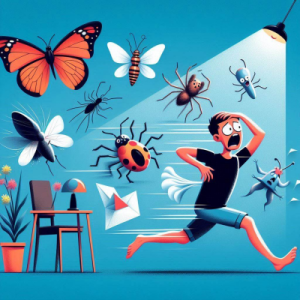Did you know that approximately 19 million adults in the United States suffer from phobias? While common fears like spiders and heights are widely recognized, there exists a domain of surprising phobias that may catch you off guard.
As you contemplate the depths of human anxiety, consider the intricate web of uncommon fears that can profoundly shape individuals’ lives. Explore the mysterious world of unique phobias and discover how these unexpected fears can impact daily existence and social interactions.
Fear of Asymmetry
 If you experience an overwhelming fear of asymmetry, known as asymmetriphobia, you may find yourself avoiding objects or situations that aren’t perfectly balanced or aligned. This fear can manifest in various ways, from feeling uncomfortable around crooked picture frames to experiencing intense anxiety in environments with irregular shapes or patterns. Asymmetriphobia can have a substantial impact on daily life, leading individuals to rearrange items obsessively or avoid certain places altogether.
If you experience an overwhelming fear of asymmetry, known as asymmetriphobia, you may find yourself avoiding objects or situations that aren’t perfectly balanced or aligned. This fear can manifest in various ways, from feeling uncomfortable around crooked picture frames to experiencing intense anxiety in environments with irregular shapes or patterns. Asymmetriphobia can have a substantial impact on daily life, leading individuals to rearrange items obsessively or avoid certain places altogether.
Symmetry therapy is a common treatment for asymmetriphobia. This form of therapy involves gradually exposing individuals to asymmetrical stimuli in a controlled setting. Through repeated exposure, patients learn to confront and manage their fear, ultimately reducing anxiety levels associated with asymmetry.
Asymmetry exposure is a key component of symmetry therapy. By gradually increasing exposure to asymmetrical objects or situations, individuals can desensitize themselves to the fear of imbalance. Over time, this exposure helps individuals build resilience and cope with asymmetry in a more adaptive manner.
Dread of Peanut Butter
Individuals experiencing a fear of peanut butter, known as arachibutyrophobia, may exhibit extreme anxiety or avoidance behaviors when confronted with this specific food item. This phobia often stems from various factors such as texture aversion, sensory discomfort, food allergies, or oral sensitivities.
The thick and sticky nature of peanut butter can trigger feelings of unease or fear in those with arachibutyrophobia due to the way it adheres to the roof of the mouth or palate.
For some individuals, the fear of peanut butter goes beyond mere dislike or preference and can lead to significant distress or panic. This phobia can impact daily life, causing individuals to avoid certain foods or social situations where peanut butter may be present.
Understanding the underlying reasons behind this fear, whether related to sensory issues or past negative experiences, is vital in providing effective support and coping mechanisms for those dealing with arachibutyrophobia.
Phobia of Chewing Sounds
Experiencing extreme discomfort or anxiety triggered by the sound of chewing is a common phobia known as misophonia. Individuals with misophonia may find it challenging to cope with everyday situations where chewing sounds are prevalent. Treatment for misophonia often involves therapy to help individuals manage their reactions to trigger sounds.
Cognitive-behavioral therapy and sound therapy are commonly used techniques to reduce the intensity of the response to chewing sounds. Additionally, using earplugs or background noise can help individuals lessen the impact of trigger sounds in their environment.
The phobia of chewing sounds can have a significant impact on social interactions and relationships. Those with misophonia may struggle to dine with others or participate in group meals due to the distress caused by chewing sounds. This can lead to feelings of isolation and frustration, affecting their relationships with friends and family.
Developing coping strategies, such as openly communicating about misophonia with loved ones and seeking support from a therapist, can help individuals navigate social situations more effectively.
Anxiety of Buttons
The anxiety associated with buttons, known as koumpounophobia, can manifest in individuals as an irrational fear or aversion towards these small fabric fasteners commonly found on clothing. This buttoned up anxiety can lead to distressing situations for those who experience it, causing them to avoid garments with buttons altogether or feel intense discomfort when buttons are present.
Fashion fears related to buttons can stem from various factors such as texture sensitivity, traumatic experiences, or even cultural influences. The aversion to these textile terror objects can be overwhelming, triggering anxiety and panic in certain individuals.
For those with koumpounophobia, maneuvering a world where buttons are a ubiquitous part of clothing can be challenging. Seeking support from mental health professionals specializing in phobias can be beneficial in managing and overcoming this specific fear. Understanding the root cause of the anxiety and learning coping mechanisms are essential steps towards alleviating the distress associated with buttons.
Avocado Aversion
Moving on from the anxiety associated with buttons, another surprising aversion that some people may experience is an intense dislike or fear towards avocados, known as avocado aversion. This food aversion is characterized by a strong aversion to the taste, smell, or texture of avocados. Individuals with avocado aversion may find the creamy texture of avocados repulsive, causing feelings of discomfort or even anxiety when faced with dishes containing this fruit.
The avocado texture, often described as buttery or smooth, can be a source of distress for those with avocado aversion. The slimy consistency of ripe avocados may trigger a visceral reaction in some individuals, leading to a strong avoidance of avocado-containing foods.
Understanding the nuances of food aversions like avocado aversion can help create more inclusive dining experiences and accommodate individuals with specific preferences or sensitivities.
If you or someone you know experiences avocado aversion, it’s essential to respect their preferences and offer alternative food options that align with their tastes.
Terror of Clowns
Why do some individuals experience an intense fear, known as coulrophobia, towards clowns?
This fear often stems from a combination of factors, including circus nightmares, childhood trauma, creepy makeup, and exaggerated smiles. Coulrophobia isn’t uncommon, with many people feeling uneasy or terrified at the sight of clowns, despite their intended role as entertainers.
Circus nightmares, where clowns are often depicted as sinister or malevolent characters, can leave a lasting impact on a person’s psyche.
Additionally, childhood trauma related to clowns, whether through a negative experience at a circus or exposure to frightening media portrayals, can contribute to the development of coulrophobia.
The exaggerated smiles and overly vibrant makeup worn by clowns can also be unsettling for some individuals, triggering feelings of discomfort or fear.
These features, meant to be jovial and entertaining, can instead be perceived as eerie or even threatening by those with coulrophobia.
Dread of Flowers
Individuals who experience coulrophobia may also find themselves overwhelmed by the irrational dread of flowers, known as anthophobia. Anthophobia is a specific phobia that can trigger intense anxiety or fear at the sight or thought of flowers. This phobia can make everyday activities challenging, especially in settings like gardens or floral shops where exposure to flowers is unavoidable.
For those with anthophobia, even the idea of floral arrangements or receiving flowers as gifts can be distressing. The fear associated with anthophobia may stem from a variety of factors, such as past negative experiences involving flowers or cultural beliefs.
Interestingly, while anthophobia presents a significant challenge for those affected, some individuals have found relief through gardening therapy. Gardening therapy involves engaging in gardening activities as a way to alleviate stress, anxiety, and phobias. The process of nurturing plants and being surrounded by nature can have a calming effect on individuals with anthophobia, providing a therapeutic outlet for their fears.
Fear of Bananas
The fear of bananas, known as bananaphobia, is a specific phobia that can trigger intense anxiety or fear at the sight or thought of this common fruit. Individuals with bananaphobia experience banana induced panic, which can manifest as rapid heartbeat, sweating, trembling, and even a sense of impending doom. This phobia often stems from a variety of factors, including traumatic experiences involving bananas, cultural influences, or even a fear of slipping on the fruit’s peel.
Bananaphobia falls under the category of specific phobias, which are characterized by an intense and irrational fear of a particular object or situation. For those who suffer from this slippery fruit phobia, everyday activities such as grocery shopping or social gatherings can become sources of significant distress.
Treatment options for bananaphobia typically include cognitive-behavioral therapy, exposure therapy, and relaxation techniques to help individuals manage their fear and anxiety surrounding bananas. Understanding and addressing this phobia is essential in improving the quality of life for those affected by it.
Phobia of Belly Buttons
Belly button phobia, also known as omphalophobia, is a specific fear that can elicit strong anxiety or distress in those who experience it. Individuals with this phobia may feel intense discomfort or fear when faced with their own belly button or the belly buttons of others. The navel nightmare can manifest in various ways, from avoiding touching or looking at belly buttons to experiencing panic attacks or extreme anxiety in situations involving exposed navels.
Button belly can be triggered by a range of factors, including past negative experiences, cultural beliefs, or even the fear of the unknown. The fear of belly buttons, or Umbilical unease, may seem unusual to some, but for those who live with it, the distress is very real.
Even mundane activities like showering or changing clothes can provoke feelings of belly button blues in individuals with omphalophobia. Seeking support from a mental health professional can help those struggling with this phobia manage their fears and lead a more comfortable life.
Anxiety of Paper
Experiencing anxiety related to paper, whether it be a fear of cuts from sharp edges or discomfort with the texture, can be a surprisingly common phobia for some individuals. The fear of paper can manifest in various forms, from distress over ink smudges to aversion towards crumpled edges. Individuals with this phobia may also find handwriting or folded corners anxiety-inducing, making daily tasks like writing notes or handling documents a source of unease.
For those with an anxiety of paper, the tactile sensations and visual aspects of paper can trigger intense feelings of discomfort or fear. The fear of paper cuts, in particular, can lead to avoidance behaviors, impacting one’s ability to engage with paper-based materials. Additionally, the fear of ink smudges or crumpled edges may result in heightened stress levels when handling paper products.
Understanding and addressing this phobia is essential for affected individuals to navigate daily life without excessive anxiety or distress. Seeking support from mental health professionals can provide strategies to manage and overcome the fear of paper, enabling individuals to function more comfortably in paper-oriented environments.
Conclusion
To sum up, it’s fascinating to uncover the world of uncommon phobias that exist beyond our everyday fears. From avoiding asymmetry to fearing peanut butter, these unique phobias offer a different perspective on the complexities of human emotions.
So next time you encounter someone with an unusual fear, remember that their anxiety may stem from something you never even considered. Embrace the diversity of fears and the quirky quirks that make us all uniquely human.





